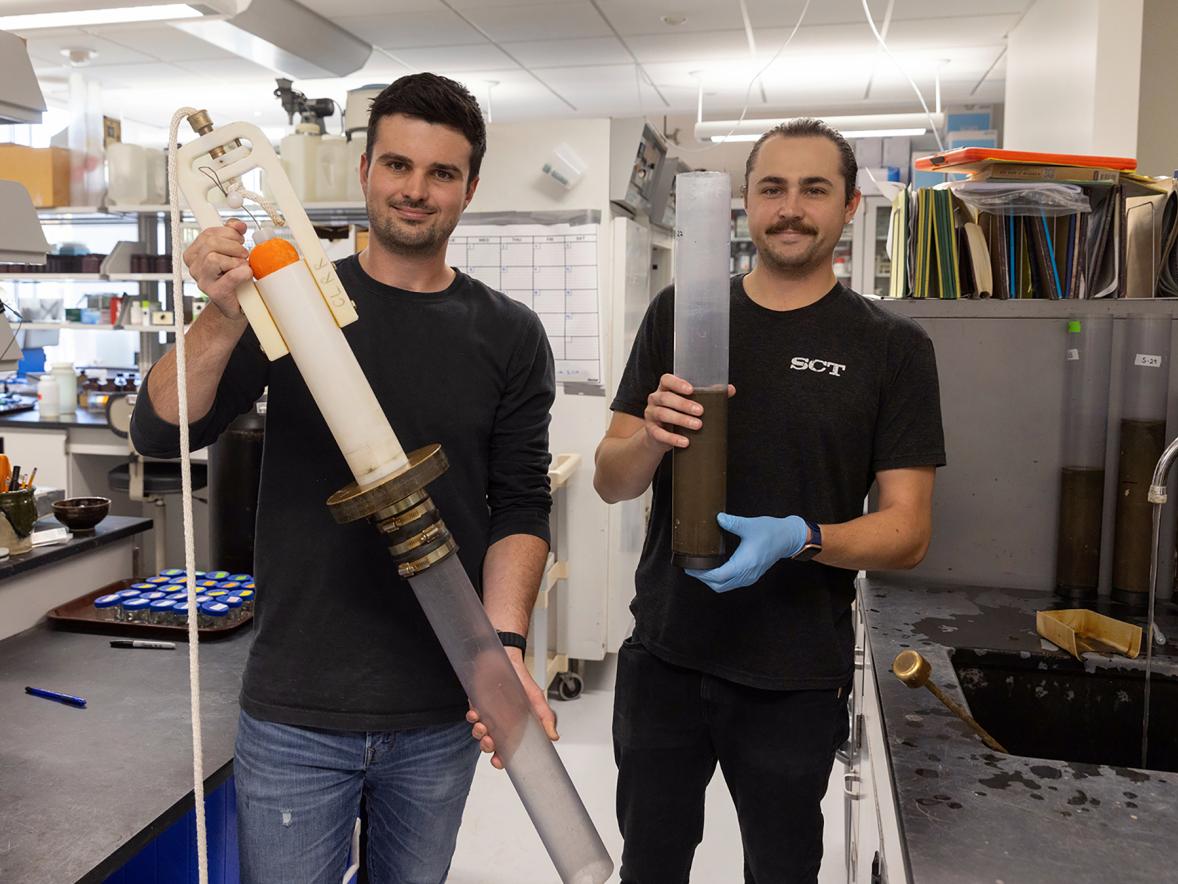On a sunny Saturday morning in May, 24 area children became young scientists in hands-on activities led by UW-Stout environmental science faculty and retired area educators at the Colfax Red Cedar Preserve and Recreation Area’s annual Science Exploration Day.
The second- to sixth-graders learned about the creatures and habitats of the preserve while exploring with volunteers UW-Stout biology professors Keith Gilland and Julia Chapman and committee members Mark Mosey and Paul Verdon in three 50-minute sessions.
Gilland and Chapman have volunteered at the preserve since 2019, collaborating with community members and UW-Stout students to enhance its habitats.
“The connection we have with the preserve has been really valuable for providing our environmental science students opportunities to do research, gain hands-on experience and develop new skills,” Chapman said.
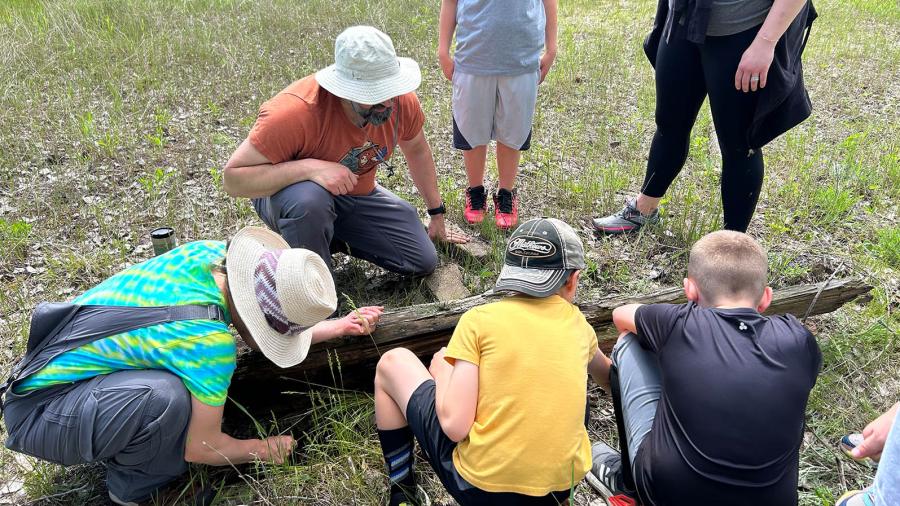
During the science day, Gilland and Chapman focused on grassland bugs and critters and the ecology of a prairie; Mosey on amphibians and reptiles; and Verdon on rocks and minerals. In turn, they learned about the children’s enthusiasm for their topics as questions and observations poured in.
“Science lends itself to wanting to share it with anyone who is genuinely interested. Children are naturally curious about their surroundings, and I feel obligated to help them better understand their world. Just seeing the interest and knowledge they possess, I have renewed hope for the future,” said Mosey, who taught life science to middle and high school students in Colfax for 33 years.
Verdon taught earth and space science in Menomonie for 33 years and served as environmental education coordinator for a decade.
“I frequently encouraged interested students to consider science as a career,” he said. “It’s so important that the general public has a good understanding of the earth and how it works, so that we can take care of it. With the changes that our environment is facing, it’s more important than ever.”
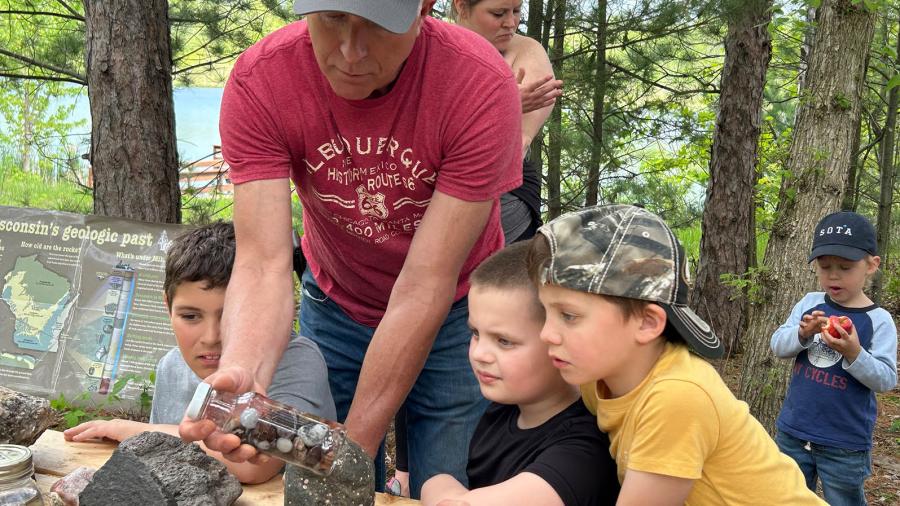
The Colfax Red Cedar Preserve and Recreation Area offers several events and activities throughout the year. Located roughly one mile north of downtown Colfax on State Road 170, it comprises more than 150 acres, with access to the Red Cedar River. The 12-acre Ferry Pond is popular for fishing and motorless boating, and a walking path takes hikers, cross-country skiers and snowshoers through wooded and prairie areas.
UW-Stout clinical mental health counseling Professor Julie Bates-Maves often visits the preserve with her family and attended the science day with her children.
“It’s a beautiful place to explore. Having Stout partner to provide programming at no cost for local children is even better. This event was so much fun. I’m so thankful for the time that Stout professors put in alongside other local educators. It’s a fantastic free resource for our region.”
Grassland bugs and critters
Gilland and Chapman led the children on a short walk through the portion of the preserve that is being rehabilitated as prairie and oak savannah, east and south of Ferry Pond. They talked about some of the prairie plants and why they are important habitat for various insects and animals at the preserve.
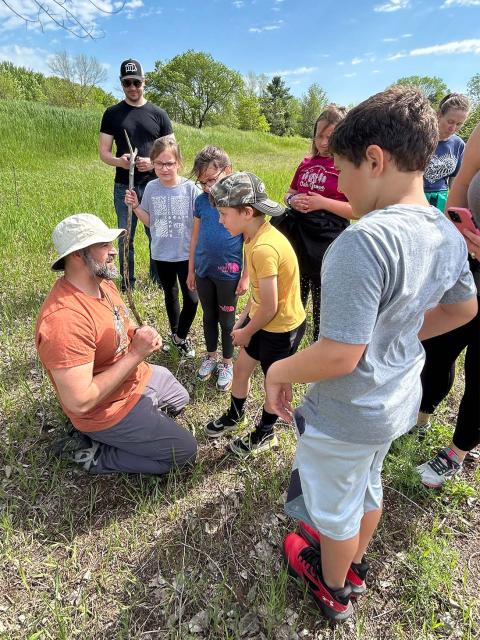
Native grasses and flowers are being replanted to create habitat for grouse, pheasants, small predators and insects. Chapman strewed native flower seeds while Gilland turned over dead logs to find roly-poly pill bugs, ants and beetles.
One of the groups spotted a painted turtle crossing the preserve road to reach the Red Cedar River. Chapman described how to identify a painted turtle by looking for the yellow lines on its head and red pattern on its belly, versus a slider turtle, which has a red stripe behind its eyes and no red on its belly. While painteds are native, sliders are non-native and are pets that people have released.
Throughout the day, they found garter snakes and five prairie skinks – a small lizard with tiny limbs that appears to move like a snake through the thick grass.
Gilland explained how the presence of the small predatory reptile is evidence of the returning health of the preserve and an indication of a returning balance to the food chain. There are small insects to feed the small reptiles and birds; and native plants to feed small herbivores and omnivores like skunks, raccoons, foxes and coyotes, as evidenced when a child found skat with hair and bone.
Amphibians and reptiles
Mosey is on the preserve’s management committee and helps document phenology on the property. His sixth-grade science teacher made science fun with a lot of hands-on learning, and his dad took him hunting and fishing at an early age.
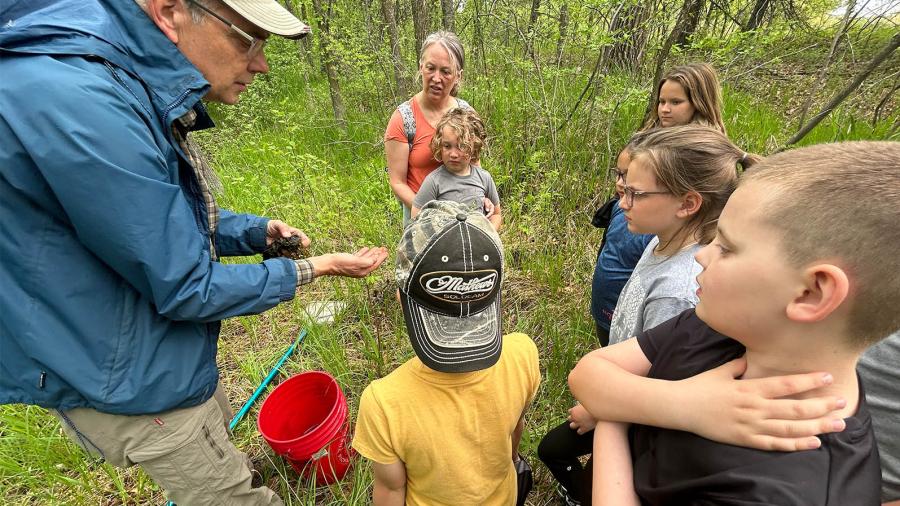
“I learned about the river ecosystem, and it became a part of me from then on,” he said. “I became a science educator because I realized how important it was to share knowledge about how things work in nature and how we as humans are part of that system.”
Walking the preserve road to the wetland area on the west side of Ferry Pond, he and the children saw painted turtles basking on a log. They passed a dead softshell turtle and talked about how its shell differs from most turtle species.
At the wetland area, Mosey had set aside a ten-gallon bucket and a small fishing net. He had hoped to net a frog or two, but instead netted some aquatic plants, algae and snail eggs for the children to examine.
On the north shore of the pond, Mosey pointed out a dried broken turtle shell. He and the children talked about the differences between amphibians and reptiles, including the structure of their eggshells, where they lay their eggs and how their young are born.
The children presented him with interesting questions and their own observations and facts, including how sea turtles return to the beach where they were born to lay their eggs and how they may dig multiple holes to lay their eggs in, to save some from predation.
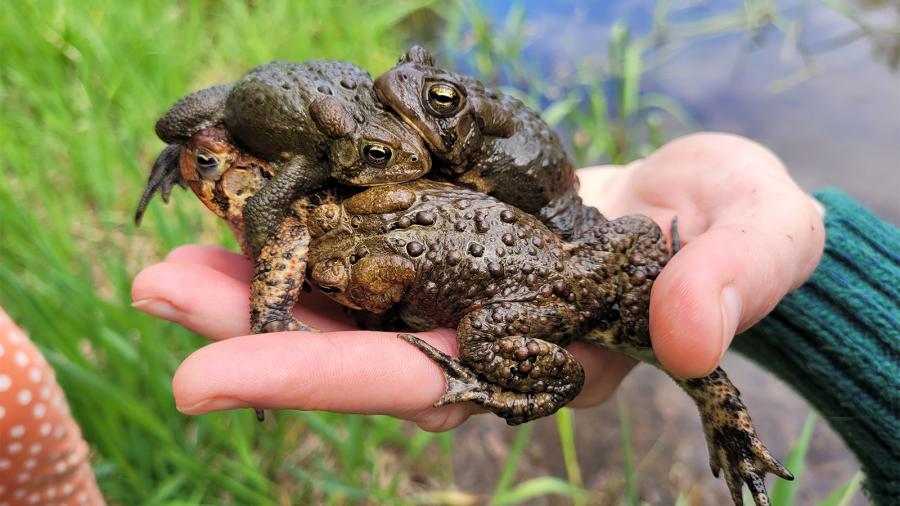
Mosey, a Wisconsin Frog and Toad Survey volunteer, helps conduct counts of the amphibians in Dunn County. He explained to the children that to count, he listens for their calls during different periods in the spring and summer, and notes either one call, two calls or a chorus of three or more.
He explained how there is only one species of toad in Wisconsin, while there are 11 species of frog. They then listened for calls, identifying spring peepers, gray treefrogs and the American toad. Mosey also played calls on his phone, and the children practiced mimicking the sounds they heard.
Rocks and minerals
Verdon, who serves on the preserve’s planning committee, grew up in northeast Iowa, exploring the Mississippi River valley. Like Mosey, he enjoyed hunting, fishing, trapping and hiking.
“This experience was a major factor in choosing a career in science education. Also, my dad was a science teacher,” Verdon said. “I’ve always tried to make science fun and engaging for my students. Hands-on science in an outdoor setting is a perfect combination.”
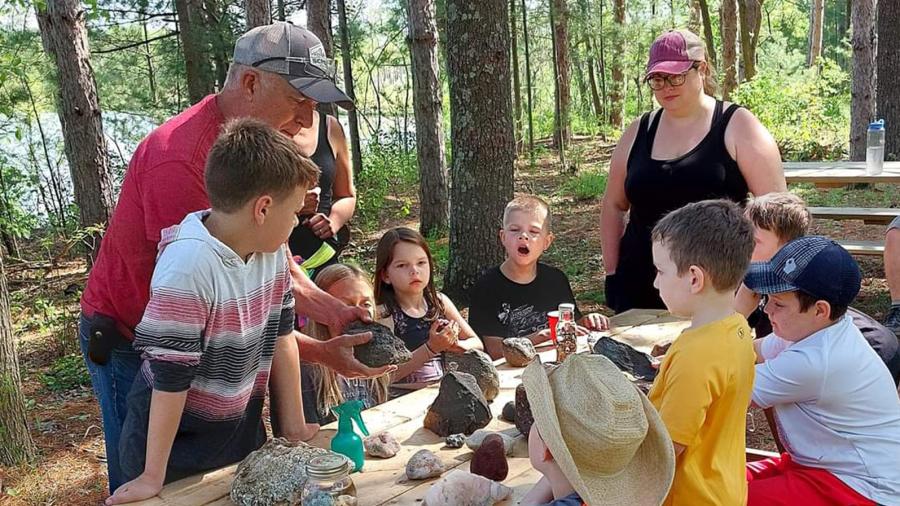
Sitting around a picnic table near the new Ferry Pond fishing pier during the exploration day, Verdon introduced children to the three types of rock – igneous, metamorphic and sedimentary. They focused largely on agates and quartz, formed deep within the earth under intense heat one billion years ago.
Verdon passed around examples from his own rock collection, explaining how quartz crystals are formed and how it is harder than most rocks, lasting long after others have eroded. Holding an apple-size agate in his hand, he sprayed it to show the children how water can bring out the true color of a rock and make its minerals shine.
They then walked along the road through the prairie area to a gravel pile to look for agates and other rocks the children could keep.
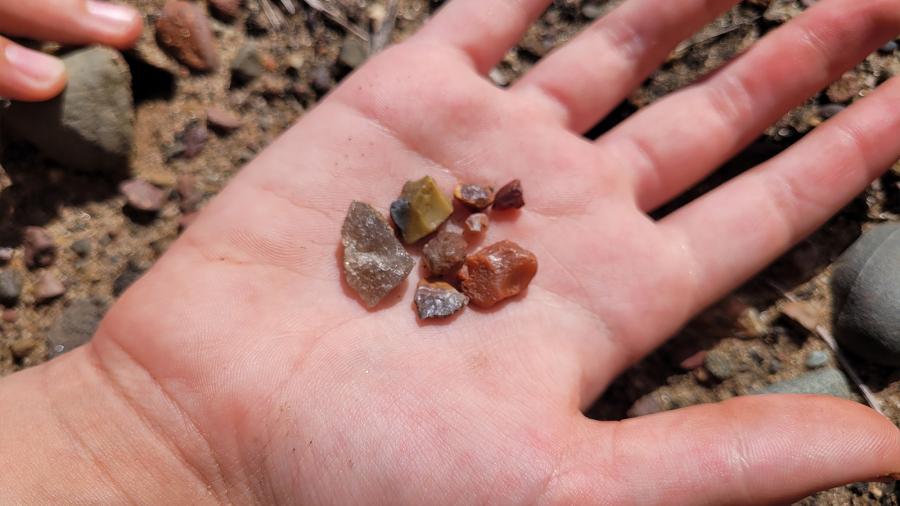
Verdon explained that the preserve is the site of an old quarry and that the gravel below their feet could be 50 feet deep because glaciers deposited a mass of rocks across the region upwards of two million years ago, when the rivers were 50 feet higher.
The children picked through the gravel, asking Verdon about the rocks they found. Even after their rock session ended and they joined their other sessions, they continued to look for agates on their walks.
Hands-on environmental activities embody polytechnic experience
Gilland and Chapman conduct controlled burns at local natural areas with the Prairie Enthusiasts, including the Colfax preserve and Dobb’s Landing, north of Lake Tainter. They recruit and train UW-Stout students to help with these burns. Gilland also instructs a one-credit chainsaw safety course.
Over the past couple of years at the preserve, they have removed invasive plant species, such as buckthorn, Siberian elm and non-native honeysuckle, from the prairie area and have seeded and planted trees.
They cut, hauled, stacked and burned organic material to expand the native grassland and to open the area around a new kestrel nesting box and osprey nesting platform.
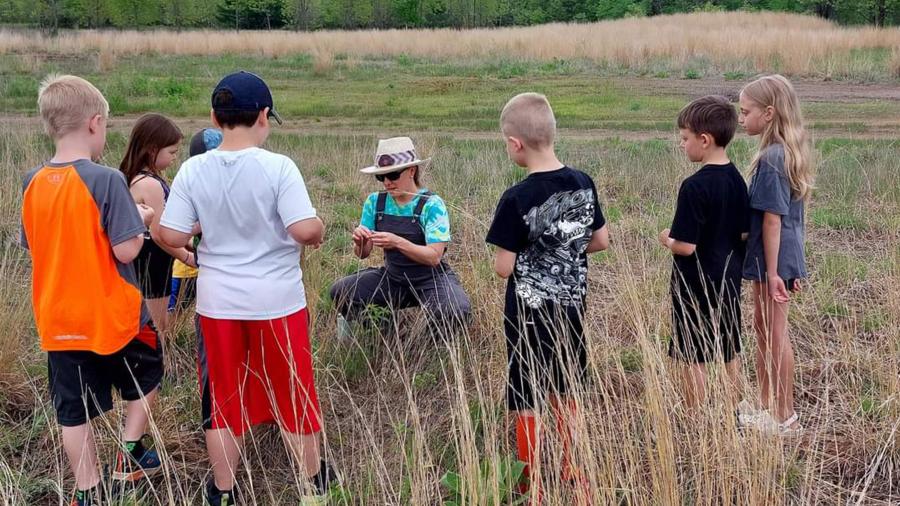
“These hands-on opportunities are a win-win. Our students get the experience of managing natural areas and the local natural areas benefit from their contributions. This embodies the polytechnic experience at UW-Stout,” said environmental science Program Director Mandy Little.
This summer, Little, Gilland, Chapman, Professor Nicole Hayes and students are studying the effects of beaver on riparian areas at Beaver Creek Reserve, in Eau Claire County; and water quality and riparian stream area management at the Gilbert and Wilson Creek trout stream restorations, as part of the Red Cedar Basin Monitoring Grant through the Wisconsin Freshwater Collaborative.
They are also studying the effects of ash die-off on the local black and green ash swamps at Muddy Creek State Wildlife Area; and will manage and monitor properties around Galloway Creek in town.
Faculty and students have also removed invasive plant species from the south shore of Lake Menomin with the Lower Chippewa Invasives Partnership; worked toward prairie restoration at Menomin Park on the northeastern shore of Lake Menomin; identified more than 200 plant species at Devil’s Punchbowl; and monitored the health of Red Cedar watershed through LAKES REU.
Civic engagement is one of UW-Stout’s enduring commitments and is at the core of preparing students to lead in their chosen fields and in their communities.





